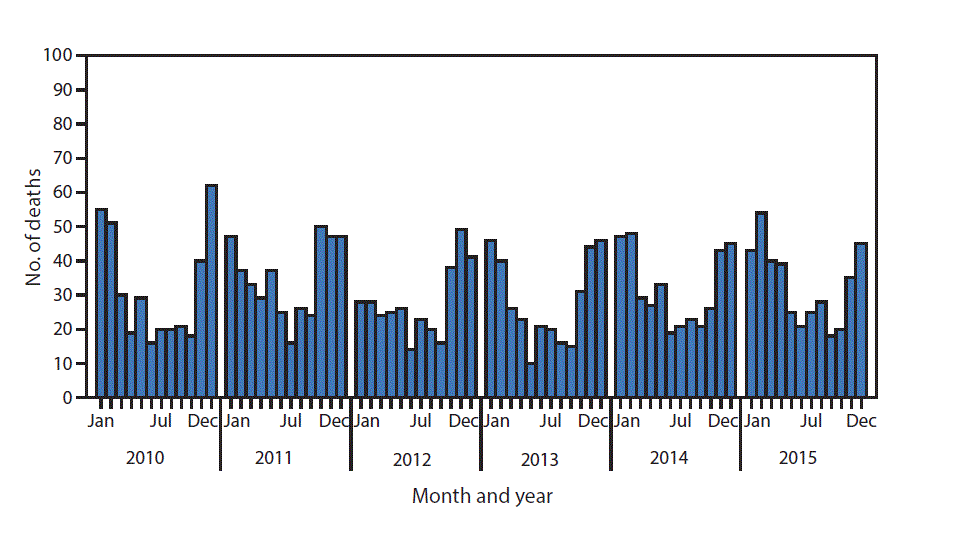Carbon monoxide is an odorless, colorless tasteless gas that is produced by burning fuel – be it wood, gasoline, propane, or charcoal. Improperly ventilated homes, garages or enclosed spaces, may allow carbon monoxide to accumulate to potentially lethal levels.
Given that the current COVID-19 pandemic has resulted in stay at home orders across the world, it may be a very important time to learn about carbon monoxide poisoning, spot symptoms and potential sources of carbon monoxide accumulation in your home.
What Is Carbon Monoxide Poisoning?
Carbon monoxide (CO) poisoning occurs when too much carbon monoxide builds up in your bloodstream. This occurs when there is too much CO in the air and oxygen in red blood cells in the body is replaced with carbon monoxide, leading to illness, serious tissue damage, and even death.
Typically, carbon monoxide poisoning deaths rise substantially during the winter months, when more people are using furnaces or otherwise burning fuel to keep warm.
Between the years of 2010–2015 alone, a total of 2,244 deaths resulting from unintentional carbon monoxide poisoning occurred in the United States (CDC, 2017), with the highest numbers of deaths each year occurring in winter months, as noted above.
Unintentional deaths occur in young and old alike, and across every demographic group. These deaths are entirely preventable. Carbon monoxide detectors are widely available and easy to install in any home. Understanding the risks associated with carbon monoxide poisoning and following simple safety tips can make all the difference.
What are the Symptoms of Carbon Monoxide Poisoning?
Carbon monoxide symptoms are often described as “flu-like.” The severity of symptoms depends upon the amount of carbon monoxide in the air. If you breathe in too much it can quickly lead to a loss of consciousness or death. People who are sleeping or drunk can die from carbon monoxide poisoning before they have any awareness of symptoms
The most common symptoms of carbon monoxide poisoning are:
- Headache
- Dizziness
- Weakness
- Nausea or upset stomach
- Vomiting
- Chest pain
- Confusion or difficulty concentrating
- Visual disturbances
Typical Sources of Carbon Monoxide in the Home
Sources of carbon monoxide – and potential poisoning – can come from:
- Heaters
- Space heaters
- Portable generators
- Fireplaces
For this reason, poisoning from carbon monoxide is especially high when it is cold outside. People who are using their appliances (stoves, ovens) to heat their homes are also putting themselves and loved ones in danger. Sitting in your car with the heater on in a garage or other enclosed space is also a dangerous practice as car engines emit carbon monoxide. Plenty of ventilation is key.
Even in summer months, exposure to carbon monoxide can be problematic:
- Water heaters in garages
- Appliances in the home
- Charcoal grills
- Lawnmowers
- Lanterns
- Fumes from certain paint remover and cleaning fluids
- Recreational vehicles with gas heaters
- Mufflers from cars and other vehicles
While most home appliances typically produce a safe amount of carbon monoxide, it is important to keep CO detectors in homes near these appliances and in enclosed spaces.
How Carbon Monoxide Poisoning Occurs in the Body
Our bodies rely on pure oxygen to transport out unhealthy wastes from the body, including carbon monoxide. Red blood cells in the lung take oxygen from inhaled air and carry it through the bloodstream to the tissues and organs. These cells need oxygen for metabolism. The red blood cells then pick up the waste products in the form of carbon dioxide (CO2) and transport it back to the lungs, where it is then exhaled out of the body into the air. If too much carbon monoxide (CO) is in the air, the oxygen in the red blood cells will be replaced with carbon monoxide, poisoning your body’s cells.
This poisoning can lead to serious tissue damage, or even death, in a matter of minutes or hours, depending upon ventilation conditions. Exposure to very low levels of carbon monoxide over weeks or months can result in symptoms similar to the flu, including headache, fatigue, a general sick feeling (called malaise), and sometimes nausea and vomiting. Symptoms of numbness, vision problems, sleep disturbances, and problems with memory and concentration may also be reported by those with long-term exposure to carbon monoxide.
The Centers for Disease Control and Prevention (CDC) estimate that more than 50,000 people are hospitalized each year in the United States for symptoms of carbon monoxide poisoning, while over 400 people die from CO poisoning.
The Difference Between Carbon Monoxide and Carbon Dioxide
Carbon monoxide (CO) is a colorless, odorless, tasteless gas produced by burning wood, propane, charcoal, gasoline, or other fuels. For that reason, it has been called the silent killer. Carbon monoxide is produced when there is an insufficient amount of air. In other words, if these fuels are burned in improperly ventilated spaces, particularly in tightly sealed or enclosed spaces, even kitchen appliances, room heaters, or small engines can cause enough carbon monoxide to accumulate to levels dangerous enough to cause sickness or death in humans and animals.
Carbon dioxide (CO2) is also a colorless, odorless, tasteless gas. Carbon dioxide comes from natural sources, like the oceans, human, animal, and plant respiration, decomposing organic matter, forest fires, and emissions from volcanic eruptions. Some of carbon dioxide in the atmosphere also comes from human activity, including burning fossil fuels like coal, natural gas, and oil, while 13% produce from human activity is the result of deforestation, changes in how we use land, and from industrial processes like cement manufacturing. While carbon monoxide is a far more dangerous gas, excess levels of carbon dioxide (CO2) in the blood (a condition called hypercapnia) can also produce a variety of ill health effects in humans and animals.
Symptoms of excess carbon dioxide (CO2) are:
- Headache
- Confusion
- Lethargy
- Dizziness
- Restlessness
- Tingling or pins or needles feeling
- Difficulty breathing, rapid breathing
- Sweating
- Tiredness
- Increased heart rate
- Elevated blood pressure
- Coma
- Asphyxia
- Convulsions
Carbon Monoxide Poisoning Diagnosis and Treatment
Carbon monoxide detectors are required to sound an alarm when CO concentrations in the air are greater than 100 ppm as continued exposure to carbon monoxide can cause permanent brain, nerve, or heart damage.
Blood tests are used to determine the amount of carbon monoxide in blood. Carbon Monoxide (CO) is measured in “parts per million” (ppm). CO levels above 70 ppm will likely cause noticeable symptoms of headache, fatigue, nausea, while levels above 150 to 200 ppm can lead to disorientation, unconsciousness, and even death.
Levels of carbon monoxide exposure range from low to dangerous:
- Low level: 50 ppm and less
- Mid-level: Between 51 ppm and 100 ppm
- High level: Greater than 101 ppm if no one is experiencing symptoms
- Dangerous level: Greater than 101 ppm if someone is experiencing symptoms
Exposure to carbon monoxide may be particularly dangerous for:
- Unborn babies. Unborn babies are more susceptible to harm from carbon monoxide poisoning as fetal blood cells take up carbon monoxide more readily than adult blood cells.
- Children. Young children take breaths more frequently than adults do, which makes a child more susceptible to carbon monoxide poisoning.
- Older adults. Older adults are more vulnerable to the neurologic effects of carbon monoxide poisoning, making them more likely to suffer brain damage and have poor cardiovascular disease outcomes, including heart failure, ischemic heart disease, heart rhythm disturbances, and cerebrovascular disease.
- People who have chronic heart disease. People with a history of heart disease, anemia, and breathing problems also are more likely to get sick from exposure to carbon monoxide.
Complications
Depending on the degree and length of exposure, carbon monoxide poisoning can cause:
- Memory problems
- Coordination difficulties
- Permanent brain damage
- Damage to the heart, possibly leading to life-threatening cardiac complications
- Fetal death or miscarriage
- Death
Safety Tips for Preventing Carbon Monoxide (CO) Poisoning
Know the sources and risks of carbon monoxide and exercise caution. The following safety tips are recommended by the CDC.
Install CO Alarms
Make sure you have CO alarms in all necessary areas of your home. If you do hear the CO alarm, immediately move to fresh air and call 911.
If you do not yet have CO alarms installed or do not have them in all the places they need to be placed, do not wait to take this life saving step.
- If you have a fireplace or an attached garage, consider installing near these. You will want one on every level (including the basement) of your home or workplace, within the vicinity of each sleeping area and in other locations required by any applicable laws/building codes.
- If you have a wood-burning fireplace or stove, make sure you keep it clean and that the flue is working properly.
- Even if the last embers are just smoldering in your fireplace, keep that flue open to let the gases escape.
Maintain your home.
- Blocked chimneys and flues can prevent CO fumes from escaping.
- Keep your vents clear.
- During and after a storm, make sure nothing is obstructing the outside stack or vent for your dryer, stove, furnace and fireplace.
- Take special care to prevent snow or other debris from building up and blocking these critical exits for dangerous gases.
Do not run engines in a closed area.
- Proper ventilation is critical to avoiding CO poisoning. Do not start a car, fire up a grill or stove, or run a generator in a closed area — like a basement or garage.
- Even if you leave the garage door open, carbon monoxide gas can quickly build up to toxic levels.
Schedule regular maintenance.
- Make sure you rely on experts to install fuel-burning devices and set up the appropriate venting for each device.
- At least once a year, have a qualified professional inspect your fuel-burning devices to make sure they continue to operate properly.
Maintain your CO alarms.
- Some CO detectors can even be interconnected across your house, so that when one detects an issue, they all sound the alarm.
- Keep in mind that CO alarms do need to be maintained regularly.
- Many carbon monoxide alarms come equipped with a battery backup to ensure uninterrupted operation, even if the power goes out. Be sure to change your batteries at the frequency recommended by the manufacturer, just like you do with your smoke detectors.
Resources
CDC. (2020). Carbon monoxide (CO) poisoning prevention. https://www.cdc.gov/features/copoisoning/index.html
CDC. (2017). QuickStats: Number of deaths resulting from unintentional carbon monoxide poisoning 2010-2015. https://www.cdc.gov/mmwr/volumes/66/wr/mm6608a9.htm
CO2Meter.com. (2009). CO and CO2 – What’s the difference? https://www.co2meter.com/blogs/news/1209952-co-and-co2-what-s-the-difference
Cunha, J.P. (2019). 19 carbon monoxide gas poisoning symptoms, causes, treatment, and risks. E Medicine Health. https://www.emedicinehealth.com/carbon_monoxide_poisoning/article_em.htm#what_are_carbon_monoxide_poisoning_symptoms_and_signs
Harvard Health Publishing. (2020). Carbon monoxide poisoning: What is it? https://www.health.harvard.edu/a_to_z/carbon-monoxide-poisoning-a-to-z
Healthline. (2017). Carbon monoxide poisoning. https://www.healthline.com/health/carbon-monoxide-poisoning
Industrial Scientific. (2019). Carbon monoxide vs. carbon dioxide: Let’s compare. https://www.indsci.com/blog-search/carbon-monoxide-vs.-carbon-dioxide-lets-compare/
Mayo Clinic. (22020). Carbon monoxide poisoning: Overview. https://www.mayoclinic.org/diseases-conditions/carbon-monoxide/symptoms-causes/syc-20370642?page=0&citems=10
MotherToBaby. (2020). Carbon monoxide fact sheet. https://mothertobaby.org/fact-sheets/carbon-monoxide-pregnancy/
What’s Your Impact. (2020). Main sources of carbon dioxide emissions. https://whatsyourimpact.org/greenhouse-gases/carbon-dioxide-emissions




No Comment